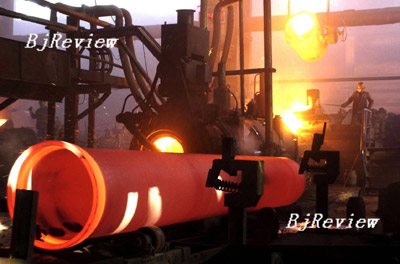|
Gao Hucheng, Vice Minister of Commerce, also hoped that the Chinese textile industry would speed up adjustment of technology structures, strengthen intellectual property right protection, establish their own brands and improve core competitiveness so as to achieve sustainable and sound development of the industry.

Iron and steel industry worries
Beginning September 15, 2006, tax rebates for the iron and steel industry were reduced 3 percentage points, from 11 percent to 8 percent. This was followed in October by the imposition of a 10-percent tariff on overseas shipments of billets, pig iron and ferroalloy. Analysts believe that this adjustment has brought heavier pressure to the industry. Since the iron and steel industry is at the break-even point right now, it is the most sensitive to adjustment of tax rebates. At present, some of the industry's products are faced with overcapacity. Hence, the selling prices of these products cannot be raised. Together with the price hikes of iron ore and energy on the international market, costs of rolled steel are coming up.
Despite changes in the tax rebate rate, China's steel exports kept surging in 2006 thanks to strong international demand and much higher steel prices on the international market. In 2006, China's exports of rolled steel soared 109.6 percent to 43.01 million tons.
However, Luo Bingsheng, Vice Chairman of the China Iron and Steel Association, predicted that the nation's steel exports in 2007 would plummet as a result of government interference. In his opinion, exports of rolled steel will drop 17.5 percent this year to 33 million tons.
Liu Shuiyang, Vice President of the Shougang Group, China's fifth largest steel mill, said his company's steel exports would be affected this year by the government's curbs. He expects to sell 1.5 million tons of rolled steel abroad this year, down from the 2 million tons estimated last year. According to him, the biggest foreign destination for the firm's rolled steel is North America, with an annual export volume of 500,000 tons in recent years.
High value-added exports welcome changes
In order to encourage high value-added industries and emerging industries, the state increased the refund rate for specific technological equipment, IT products and biological and medical products by 4 percentage points to 17 percent, while those of agricultural products were raised 2-8 percentage points to 13 percent.
"This shows that the government attaches importance to both development and stability, for mechanic and hi-tech products are the future for our industrial development," said Mei Xinyu. "Increasing the tax rebate rate for agricultural products also aims at stability."
Industry insiders believe that the increase of tax rebates for mechanic and electrical products will help development of the industry. On the one hand, the increase of the refund rate can cut export costs of these products and promote improvement of product mix and industrial structure. Raising the tax rebate particularly for power generation equipment should help with their exports.
On the other hand, since rebate rates for most rolled steel are reduced 3 percentage points and those for non-ferrous metals are cut by 2-8 percentage points, more materials for mechanic and electrical products may be sold in the domestic market. Reducing the tax rebate rate for rolled steel and non-ferrous metals will intensify competition in the domestic market, and thus, knock down prices of raw materials. The result is a reduction in costs of mechanical products and an improvement in their economic returns.
The tax rebate increase of biological and medical products is also believed to encourage their exports. "With the increase of export refunding, international competitiveness of Chinese pharmaceutical companies can be improved," said Jiang Zhenwei, General Manager of the Shanghai Medicines and Health Products Import and Export Corp.
According to him, the strongest rival of China's pharmaceutical industry is India, which returns all the tariffs it collects on medicine exporters. At present, the average quotation of exported medicines by Chinese companies is lower than the average price on the international market. If the exporters can get more tax rebates, they can offer lower quotations for exports.
However, industrial insiders may be not satisfied with the 4-percentage-point tax rebate increase. "Actually tax rebates for all medical preparations should be raised since the country's exporting volume is not large. A 4-percentage-point increase of tax rebates will not impose a significant burden on the government, but companies will benefit a lot," said an anonymous official of the China Chamber of Commerce for Import and Export of Medicines and Health Products.
Since the rise of tax rebates has been adopted for only a few months, companies cannot yet estimate the exact benefits, but many still figure that they will benefit from the policy.
"This shows the country's encouragement of medicine exports," said Chen Qiyu, Executive Vice President of FOSUN Pharmaceuticals (Group) Corp.
| 